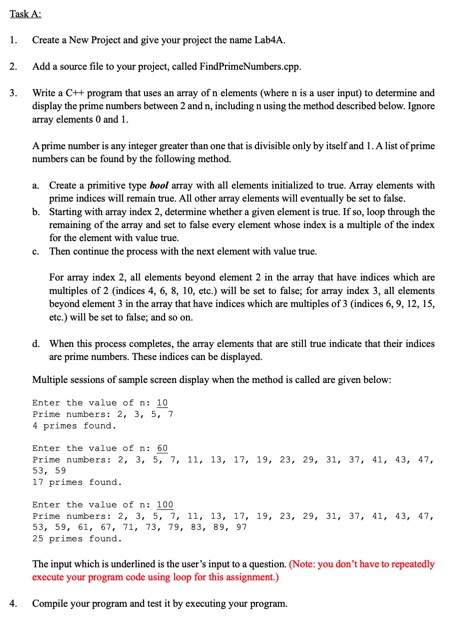Question
Task A: 1. New Project and give your project the name Lab4A. 2. Add a source file to your project, called FindPrimeNumbers.cpp. 3. C++ program
Task A: 1. New Project and give your project the name Lab4A. 2. Add a source file to your project, called FindPrimeNumbers.cpp. 3. C++ program that uses an array of n elements (where n is a user input) to determine and display the prime numbers between 2 and n, including n using the method described below. Ignore array elements 0 and 1. A prime number is any integer greater than one that is divisible only by itself and 1. A list of prime numbers can be found by the following method. a. primitive type bool array with all elements initialized to true. Array elements with prime indices will remain true. All other array elements will eventually be set to false. b. Starting with array index 2, determine whether a given element is true. If so, loop through the remaining of the array and set to false every element whose index is a multiple of the index for the element with value true. c. Then continue the process with the next element with value true. For array index 2, all elements beyond element 2 in the array that have indices which are multiples of 2 (indices 4, 6, 8, 10, etc.) will be set to false; for array index 3, all elements beyond element 3 in the array that have indices which are multiples of 3 (indices 6, 9, 12, 15, etc.) will be set to false; and so on. d. When this process completes, the array elements that are still true indicate that their indices are prime numbers. These indices can be displayed. Multiple sessions of sample screen display when the method is called are given below: Enter the value of n: 10 Prime numbers: 2, 3, 5, 7 4 primes found. Enter the value of n: 60 Prime numbers: 2, 3, 5, 7, 11, 13, 17, 19, 23, 29, 31, 37, 41, 43, 47, 53, 59 17 primes found. Enter the value of n: 100 Prime numbers: 2, 3, 5, 7, 11, 13, 17, 19, 23, 29, 31, 37, 41, 43, 47, 53, 59, 61, 67, 71, 73, 79, 83, 89, 97 25 primes found. The input which is underlined is the user's input to a question. (Note: you don't have to repeatedly execute your program code using loop for this assignment.) 4. Compile your program and test it by executing your program.

Step by Step Solution
There are 3 Steps involved in it
Step: 1

Get Instant Access to Expert-Tailored Solutions
See step-by-step solutions with expert insights and AI powered tools for academic success
Step: 2

Step: 3

Ace Your Homework with AI
Get the answers you need in no time with our AI-driven, step-by-step assistance
Get Started


